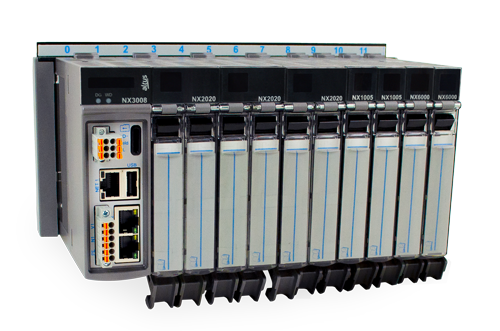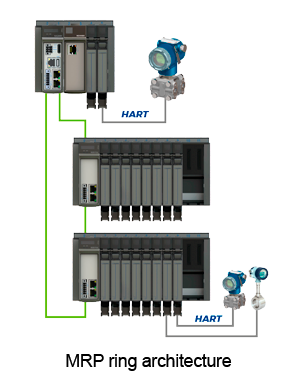
NX3008, your next step towards an industry fully integrated to the 4.0 Universe
Altus` continuous investment in research and development provides the design of high-tech equipment, solutions that adhere to the reality of the international industry and capable of meeting the most varied demands of a changing market. This innovative vein is part of the company`s DNA, an intrinsic characteristic in each of the products developed throughout our 40 years of history. Now, this same vocation for innovation brings to the global industry a CPU with advanced software and cybersecurity functionalities capable of dynamically integrating the IT and OT areas of your business.
NX3008, Nexto Series` new processing unit, arrives as a complete solution for systems in different segments and with the most varied complexities. With robust hardware and advanced software features that allow it to be used both in machines and in process market applications, the CPU delivers performance, connectivity and versatility for the most varied demands of Industry 4.0. Discover the main highlights of the new Altus CPU and discover how it can boost performance and increase your company`s competitiveness.
Go to the official launch page to download the technical documentation of one of the most complete products on the world automation market.
A PLC with high availability and high performance
 Preemptive and multi-tasking, the operating system of the new NX3008 CPU operates based on a high-speed 64-bit ARM processor with 1 GHz clock, 3x faster than previous line models. These features also allow it to control more than 2,000 input and output points as well as process complex arithmetic calculations, advanced control functions and more than 1,000 PID loops in up to 2 milliseconds.
Preemptive and multi-tasking, the operating system of the new NX3008 CPU operates based on a high-speed 64-bit ARM processor with 1 GHz clock, 3x faster than previous line models. These features also allow it to control more than 2,000 input and output points as well as process complex arithmetic calculations, advanced control functions and more than 1,000 PID loops in up to 2 milliseconds.
To guarantee the completeness of the application where it is applied, the Altus newest CPU has 1 MB retentive data memory. This feature, seen in the most advanced control equipment, prevents the loss of operation data due to unexpected shutdowns or communication failures between the bus and the CPU. The programmable controller also has advanced features inherited from Nexto Series, such as One Touch Diag (OTD), Easy Plug System (EPS) and Multiple Block Storage (MBS).
Another feature of Nexto products that is also present in the new CPU is the conformal coating. In the process a thin layer of non-conductive material is applied to the product`s plate to protect against corrosion, extreme temperatures, sea air, humidity, among other factors. This extra protection preserves the investment and keeps the automation system up and running longer.
As a product designed to meet the demands of a global industry, the NX3008 was designed to comply with the main certifications on the market. In addition to the CE marking, mandatory for any electrical and electronic equipment that has aspirations to be export to the European Union, the product will also have the DNV certification. The standard is a requirement for companies in Asia, Europe and North America to use programmable controllers in marine applications, such as vessel control systems and oil and gas production platforms.
Also, in the coming months the CPU should receive UL and cUL certifications, mandatory requirements for exporting products to the United States and Canada.
Communication and connectivity features
 Created to meet the demands of an increasingly connected industry, the NX3008 CPU has a wide variety of communication interfaces capable of connecting the equipment to the most different systems and machines on the market. The new Nexto Series control device has 02 Ethernet interfaces which support the PROFINET Controller communication protocol, which allows the controller to be used in a network with MRP ring architecture. The controller also counts on 01 Gigabit Ethernet port.
Created to meet the demands of an increasingly connected industry, the NX3008 CPU has a wide variety of communication interfaces capable of connecting the equipment to the most different systems and machines on the market. The new Nexto Series control device has 02 Ethernet interfaces which support the PROFINET Controller communication protocol, which allows the controller to be used in a network with MRP ring architecture. The controller also counts on 01 Gigabit Ethernet port.
The equipment also has an RS-485 port and a CAN port for connection to field networks, a USB interface for connecting modems and a MicroSD memory card for data storage. This profusion of connectivity resources allows the new Altus CPU to be applied in architectures with varied communication networks. In addition to the PROFINET standard, the equipment also supports other important communication protocols, such as PROFIBUS-DP, MODBUS/RTU, MODBUS/TCP, MODBUS RTU/TCP, EtherNet/IP, EtherCAT Master, IEC 60870-5-104, CANopen and J-1939, OPC DA, OPC UA and MQTT.
The product, like other Nexto Series equipment, uses the MasterTool IEC XE programming software, a technological platform based on CODESYS with scalability for micro to large projects (free of charge up to 320 I/O points). Fully adherent to the IoT universe, the CPU has the ability to write directly to a SQL database and directly interact with the most relevant cloud hosting services on the market, such as Microsoft Azure, IBM Cloud, Google One and Amazon AWS. The unit also has a differential present in few PLCs on the market: the unit has an embedded WebServer, a tool that allows the creation of application supervision and monitoring screens without the need to use a SCADA system.
Advanced software and cybersecurity features

The new Altus CPU also supports FTP connections, which enables the device to exchange data with a server that uses this technology model. This functionality allows data packets generated by the controller, such as logs collected through a datalogger function, to be accessed remotely.
Another new feature available on the NX3008 is its embedded Docker platform. The feature, native to the CPU, makes it possible to virtualize software developed for operating systems with Unix technology. The feature gives more versatility and speed to the operation of the system, as it allows the processing of multiple data within the CPU itself.




